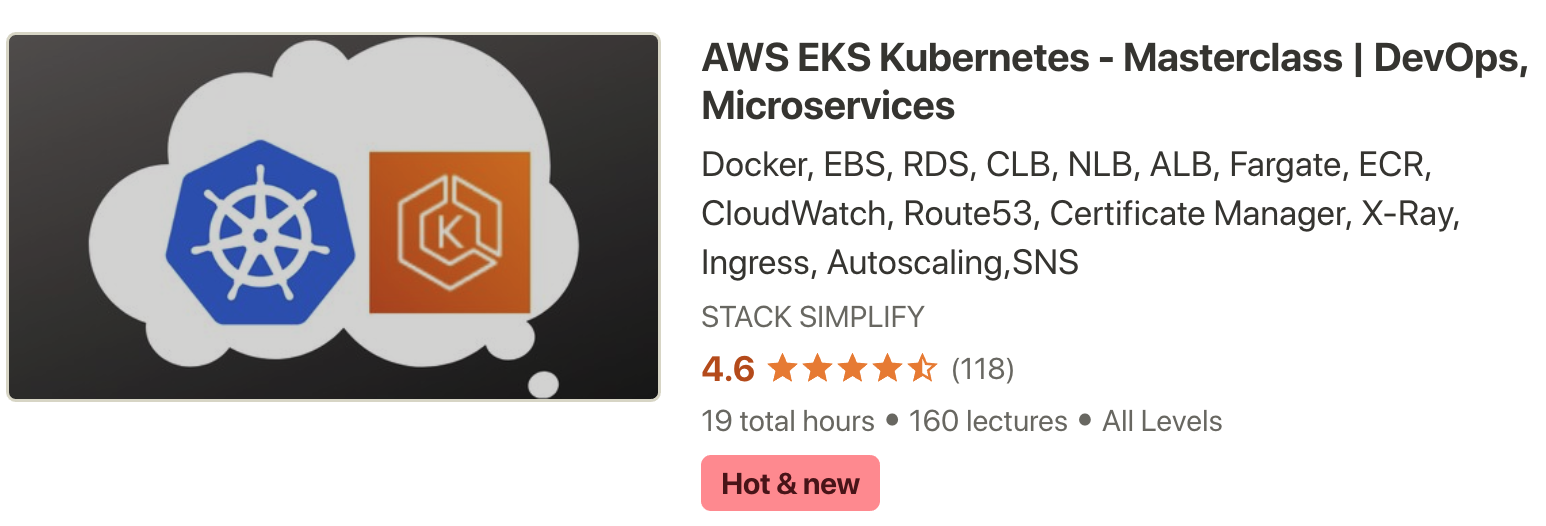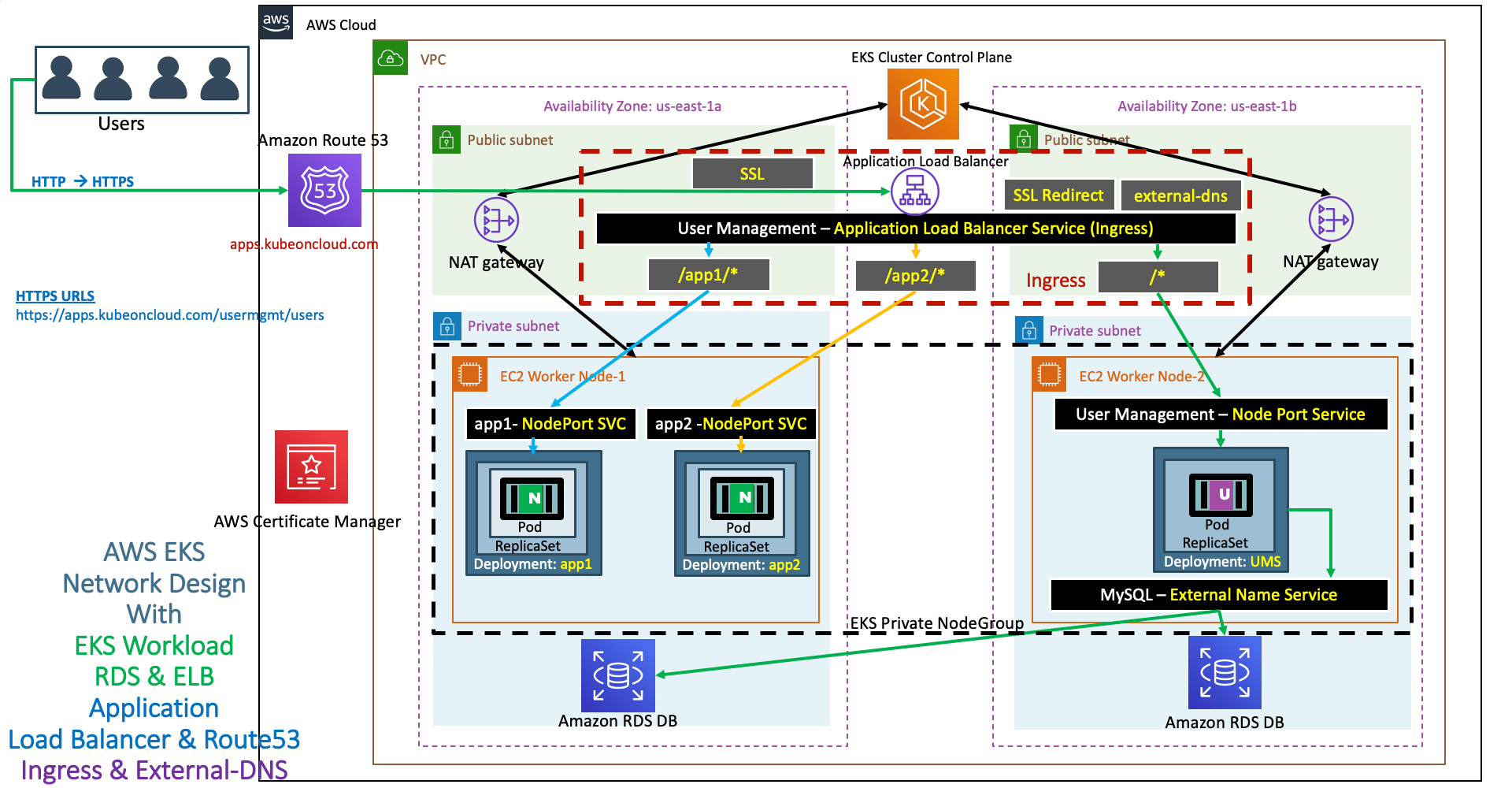External DNS - Use it for our Applications ¶
Step-01: Update Ingress manifest by adding External DNS Annotation ¶
- Added annotation with two DNS Names
- dnstest1.kubeoncloud.com
- dnstest2.kubeoncloud.com
- Once we deploy the application, we should be able to access our Applications with both DNS Names.
- 07-ALB-Ingress-SSL-Redirect-ExternalDNS.yml
# External DNS - For creating a Record Set in Route53 external-dns.alpha.kubernetes.io/hostname: dnstest1.kubeoncloud.com, dnstest2.kubeoncloud.com - In your case it is going to be, replace
yourdomainwith your domain name - dnstest1.yourdoamin.com
- dnstest2.yourdoamin.com
- Refer Presentation from slide 106 onwards
Kubernetes Manifests ¶
#01-MySQL-externalName-Service.yml
apiVersion: v1
kind: Service
metadata:
name: mysql
spec:
type: ExternalName
externalName: usermgmtdb.cxojydmxwly6.us-east-1.rds.amazonaws.com
#02-UserManagementMicroservice-Deployment-Service.yml
apiVersion: apps/v1
kind: Deployment
metadata:
name: usermgmt-microservice
labels:
app: usermgmt-restapp
spec:
replicas: 1
selector:
matchLabels:
app: usermgmt-restapp
template:
metadata:
labels:
app: usermgmt-restapp
spec:
initContainers:
- name: init-db
image: busybox:1.31
command: ['sh', '-c', 'echo -e "Checking for the availability of MySQL Server deployment"; while ! nc -z mysql 3306; do sleep 1; printf "-"; done; echo -e " >> MySQL DB Server has started";']
containers:
- name: usermgmt-restapp
image: stacksimplify/kube-usermanagement-microservice:1.0.0
ports:
- containerPort: 8095
env:
- name: DB_HOSTNAME
value: "mysql"
- name: DB_PORT
value: "3306"
- name: DB_NAME
value: "usermgmt"
- name: DB_USERNAME
value: "dbadmin" # RDS DB Username is dbadmin
- name: DB_PASSWORD
valueFrom:
secretKeyRef:
name: mysql-db-password
key: db-password
livenessProbe:
exec:
command:
- /bin/sh
- -c
- nc -z localhost 8095
initialDelaySeconds: 60
periodSeconds: 10
readinessProbe:
httpGet:
path: /usermgmt/health-status
port: 8095
initialDelaySeconds: 60
periodSeconds: 10
#03-Kubernetes-Secrets.yml
apiVersion: v1
kind: Secret
metadata:
name: mysql-db-password
type: Opaque
data:
db-password: ZGJwYXNzd29yZDEx
#04-UserManagement-NodePort-Service.yml
apiVersion: v1
kind: Service
metadata:
name: usermgmt-restapp-nodeport-service
labels:
app: usermgmt-restapp
annotations:
#Important Note: Need to add health check path annotations in service level if we are planning to use multiple targets in a load balancer
alb.ingress.kubernetes.io/healthcheck-path: /usermgmt/health-status
spec:
type: NodePort
selector:
app: usermgmt-restapp
ports:
- port: 8095
targetPort: 8095
#05-Nginx-App1-Deployment-and-NodePortService.yml
apiVersion: apps/v1
kind: Deployment
metadata:
name: app1-nginx-deployment
labels:
app: app1-nginx
spec:
replicas: 1
selector:
matchLabels:
app: app1-nginx
template:
metadata:
labels:
app: app1-nginx
spec:
containers:
- name: app1-nginx
image: stacksimplify/kube-nginxapp1:1.0.0
ports:
- containerPort: 80
---
apiVersion: v1
kind: Service
metadata:
name: app1-nginx-nodeport-service
labels:
app: app1-nginx
annotations:
#Important Note: Need to add health check path annotations in service level if we are planning to use multiple targets in a load balancer
alb.ingress.kubernetes.io/healthcheck-path: /app1/index.html
spec:
type: NodePort
selector:
app: app1-nginx
ports:
- port: 80
targetPort: 80
#06-Nginx-App2-Deployment-and-NodePortService.yml
apiVersion: apps/v1
kind: Deployment
metadata:
name: app2-nginx-deployment
labels:
app: app2-nginx
spec:
replicas: 1
selector:
matchLabels:
app: app2-nginx
template:
metadata:
labels:
app: app2-nginx
spec:
containers:
- name: app2-nginx
image: stacksimplify/kube-nginxapp2:1.0.0
ports:
- containerPort: 80
---
apiVersion: v1
kind: Service
metadata:
name: app2-nginx-nodeport-service
labels:
app: app2-nginx
annotations:
#Important Note: Need to add health check path annotations in service level if we are planning to use multiple targets in a load balancer
alb.ingress.kubernetes.io/healthcheck-path: /app2/index.html
spec:
type: NodePort
selector:
app: app2-nginx
ports:
- port: 80
targetPort: 80
#07-ALB-Ingress-SSL-Redirect-with-ExternalDNS.yml
# Annotations Reference: https://kubernetes-sigs.github.io/aws-alb-ingress-controller/guide/ingress/annotation/
apiVersion: extensions/v1beta1
kind: Ingress
metadata:
name: ingress-usermgmt-restapp-service
labels:
app: usermgmt-restapp
annotations:
# Ingress Core Settings
kubernetes.io/ingress.class: "alb"
alb.ingress.kubernetes.io/scheme: internet-facing
# Health Check Settings
alb.ingress.kubernetes.io/healthcheck-protocol: HTTP
alb.ingress.kubernetes.io/healthcheck-port: traffic-port
#Important Note: Need to add health check path annotations in service level if we are planning to use multiple targets in a load balancer
#alb.ingress.kubernetes.io/healthcheck-path: /usermgmt/health-status
alb.ingress.kubernetes.io/healthcheck-interval-seconds: '15'
alb.ingress.kubernetes.io/healthcheck-timeout-seconds: '5'
alb.ingress.kubernetes.io/success-codes: '200'
alb.ingress.kubernetes.io/healthy-threshold-count: '2'
alb.ingress.kubernetes.io/unhealthy-threshold-count: '2'
## SSL Settings
alb.ingress.kubernetes.io/listen-ports: '[{"HTTPS":443}, {"HTTP":80}]'
alb.ingress.kubernetes.io/certificate-arn: arn:aws:acm:us-east-1:180789647333:certificate/9f042b5d-86fd-4fad-96d0-c81c5abc71e1
#alb.ingress.kubernetes.io/ssl-policy: ELBSecurityPolicy-TLS-1-1-2017-01 #Optional (Picks default if not used)
# SSL Redirect Setting
alb.ingress.kubernetes.io/actions.ssl-redirect: '{"Type": "redirect", "RedirectConfig": { "Protocol": "HTTPS", "Port": "443", "StatusCode": "HTTP_301"}}'
# External DNS - For creating a Record Set in Route53
external-dns.alpha.kubernetes.io/hostname: dnstest1.kubeoncloud.com, dnstest2.kubeoncloud.com
spec:
rules:
#- host: ssldemo.kubeoncloud.com # SSL Setting (Optional only if we are not using certificate-arn annotation)
- http:
paths:
- path: /* # SSL Redirect Setting
backend:
serviceName: ssl-redirect
servicePort: use-annotation
- path: /app1/*
backend:
serviceName: app1-nginx-nodeport-service
servicePort: 80
- path: /app2/*
backend:
serviceName: app2-nginx-nodeport-service
servicePort: 80
- path: /*
backend:
serviceName: usermgmt-restapp-nodeport-service
servicePort: 8095
# Important Note-1: In path based routing order is very important, if we are going to use "/*", try to use it at the end of all rules.
Step-02: Deploy all Application Kubernetes Manifests ¶
Deploy ¶
# Deploy
kubectl apply -f kube-manifests/
Verify Load Balancer & Target Groups ¶
- Load Balancer - Listeneres (Verify both 80 & 443)
- Load Balancer - Rules (Verify both 80 & 443 listeners)
- Target Groups - Group Details (Verify Health check path)
- Target Groups - Targets (Verify all 3 targets are healthy)
- Verify ingress controller from kubectl
Verify External DNS Log ¶
# Verify External DNS logs
kubectl logs -f $(kubectl get po | egrep -o 'external-dns[A-Za-z0-9-]+')
time="2020-05-29T04:25:55Z" level=info msg="Desired change: CREATE dnstest1.kubeoncloud.com A [Id: /hostedzone/Z29P9D94N7I5H5]"
time="2020-05-29T04:25:55Z" level=info msg="Desired change: CREATE dnstest2.kubeoncloud.com A [Id: /hostedzone/Z29P9D94N7I5H5]"
time="2020-05-29T04:25:55Z" level=info msg="Desired change: CREATE dnstest1.kubeoncloud.com TXT [Id: /hostedzone/Z29P9D94N7I5H5]"
time="2020-05-29T04:25:55Z" level=info msg="Desired change: CREATE dnstest2.kubeoncloud.com TXT [Id: /hostedzone/Z29P9D94N7I5H5]"
time="2020-05-29T04:25:55Z" level=info msg="4 record(s) in zone zetaoptdemo.com. [Id: /hostedzone/Z29P9D94N7I5H5] were successfully updated"
time="2020-05-29T04:26:55Z" level=info msg="All records are already up to date"
time="2020-05-29T04:27:55Z" level=info msg="All records are already up to date"
time="2020-05-29T04:28:55Z" level=info msg="All records are already up to date"
Verify Route53 ¶
- Go to Services -> Route53
- You should see Record Sets added for
dnstest1.kubeoncloud.com,dnstest2.kubeoncloud.com
Best Selling AWS EKS Kubernetes Course on Udemy ¶
- Absolute practical scenarios required for real-time implementations
- 18 AWS Services covered in combination with AWS EKS
- 31 Kubernetes Concepts covered in combination with AWS EKS & AWS Services
- Step by Step Documentation on Github and Website
- 18 Docker Images available on Docker Hub for implementing practical scenarios

Step-04: Access Application using newly registered DNS Name ¶
Perform nslookup tests before accessing Application ¶
- Test if our new DNS entries registered and resolving to an IP Address
# nslookup commands nslookup dnstest1.kubeoncloud.com nslookup dnstest2.kubeoncloud.com
Access Application using dnstest1 domain ¶
# HTTP URLs (Should Redirect to HTTPS)
http://dnstest1.kubeoncloud.com/app1/index.html
http://dnstest1.kubeoncloud.com/app2/index.html
http://dnstest1.kubeoncloud.com/usermgmt/health-status
Access Application using dnstest2 domain ¶
# HTTP URLs (Should Redirect to HTTPS)
http://dnstest2.kubeoncloud.com/app1/index.html
http://dnstest2.kubeoncloud.com/app2/index.html
http://dnstest2.kubeoncloud.com/usermgmt/health-status
Step-05: Clean Up ¶
kubectl delete -f kube-manifests/
References ¶
- https://github.com/kubernetes-sigs/external-dns/blob/master/docs/tutorials/alb-ingress.md
- https://github.com/kubernetes-sigs/external-dns/blob/master/docs/tutorials/aws.md
How ALB Ingress Controller Works? ¶
AWS ALB Ingress Installation ¶
AWS ALB Ingress Implementation Basics ¶
Subscribe to our Youtube Channel

